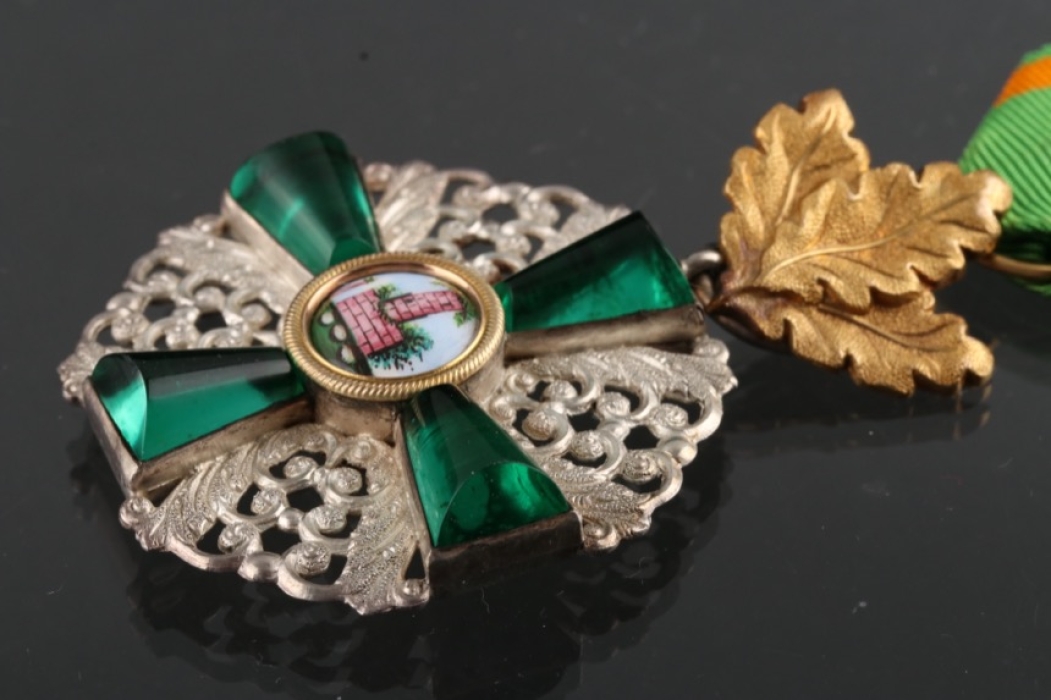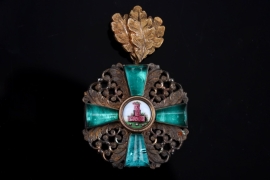Knight's Cross 2nd Class with Oak Leaves
Buy treasures for a reduced Buyer‘s Premium

Baden - Order of the Zähringer Lion Knight's Cross 2nd Class with Oak Leaves
MILITARIA PRICE GUIDE
How can I see prices?
Welcome to the ratisbon's MILITARIA PRICE GUIDE!
To access all prices, pictures, and descriptions please subscribe to our MILITARIA PRICE GUIDE at www.ratisbons.com/militaria-price-guide. Save 25% when subscribing for one year! Get full access for just 75€!
We are buying single items and entire collections! Call +49 8541 9053699
-
PAYMENT
-
HOW CAN I PAY FOR MY ORDER?
AUCTIONSYou will receive an e-mail confirming your successful bids the day after the auction has ended. In your personal my ratisbon's you will be able to inform us about your most convenient payment method for this order or tell us about an alternative shipping address.
If we don’t hear from you within 24 hours, we will send an invoice choosing the payment and shipping options which we think are the most comfortable ones to you. If you decide to change your shipping or payment method after receiving your invoice, just drop us a line or visit my ratisbon's/ORDERS for any more details.
SHOP ORDERSChoose your payment method when ordering and submit your order. Once your order has been received we will send an invoice including your shipping costs and your payment instructions.
After receiving the invoice, the order must be paid within 7 days.
Please contact us to discuss layaway options.To learn more about paying at ratisbon's, please see your FAQ pages.
WE ACCEPT FOLLOWING PAYMENT METHODS
-
-
Versand
-
HOW DO YOU SHIP MY NEW TREASURES?
PACKING & TRACKINGWe usually send out orders within 1-3 working days after your payment has been received. In most cases, we are faster than this! We will inform you when your goods are being dispatched and provide a tracking number, In addition, you can always check your order status at my ratisbon's/ORDERS. Delivery times will vary depending upon the delivery destination and type of shipping service you have chosen.
SHIPPING TO ALTERNATIVE ADDRESSIf you prefer to have your order shipped to your work address or a friend during your absence, we will happy to arrange this for you. Send us an email letting us know about your new shipping address and we will be happy to send an updated invoice to you.
OUR LOGISTIC PARTNERS ARE AS FOLLOWS
-
-
OUR GUARANTEE
-
 OUR GUARANTEE!
OUR GUARANTEE!We only offer collectables which to the best of our specialists knowledge are authentic. About 15% of all consignments are returned to the consignor after extensive research due to authenticity issues.
Unlike traditional auction houses we do offer a full right of return. If you are not satisfied with what you won or bought, you may return it within 14 days. Please inform us and we will instruct you on how to return the goods. For more information, please visit FAQ pages.
Important note: Cancelling bids after an auction may disappoint the consignor, who like you is a collector. This situation is easy to avoid. We encourage you not to bid on any collectable if you are unsure if it fits into your collection. Ask us to cancel your bid 24 hours prior to the end of an auction to avoid this situation.
-
COUNTRY Imperial Germany
DIMENSIONS 43.3 x 40.2 mm
WEIGHT 22 g with ribbon
 US LOT US3-0299
US LOT US3-0299EAN 3000000016503
 US LOT US3-0299
US LOT US3-0299PERIOD until 1918
COUNTRY Imperial Germany
MATERIAL gold, silver
DIMENSIONS 43.3 x 40.2 mm
MAKER view maker
WEIGHT 22 g with ribbon
COUNTRY Imperial Germany
 US LOT US3-0299
US LOT US3-0299DIMENSIONS 43.3 x 40.2 mm
EAN 3000000016503
MAKER view maker
WEIGHT 22 g with ribbon
Knight's Cross 2nd Class with Oak Leaves
Description
This knight’s cross 2nd class with oak leaf is made from silver and enamel. The Cross arms are made from green glass. The oak leaf itself is made in a hollow fashion from real gold and is attached to the cross by means of a silver ring and suspended from the ribbon through a golden ring. The cross is likely made by Zimmermann and delivered to the orders chancellery after 1900.
Beautiful decoration in stunning condition.
Condition
1-
Seller
History Trader Inc., 521 Thorn Street #165, Sewickly, PA 15143-0165, USA
Grand Duke Karl of Baden founded the order to reward commoners as well as foreigners on December 26, 1812 without issuing statutes. Initial awards were made already in 1815, whereas the new Zaehringer Lion was broken down into three classes: the Grand Crosses, Commanders and Knights of the order. The Grand Duke himself was the grandmaster and the prince’s members by birth of the order.
Attempts to draft and issue formal statues were made in 1819. Finally, on June 25, 1840, statutes were issued by now Grand Duke Leopold. The order of the Zaehringer Lion now had four classes, as the Commander was split into a 1st and 2nd class with or without star. It’s motto was: ”Für Ehre und Wahrheit” (For honor and truth). To superimpose on special deeds an oak leaf cluster could be added to the order. Only the initial awards during the 1820th with oak leaf were different in design and showed the cypher of the Grand Duke “L” affixed to the three-leaf cluster.
Grand Duke Friedrich I. changed the statutes in 1866 to now split the Knight cross into two classes, the Knight 1st and 2nd class, therefore extended the order to five grades. He also added swords to the order for awarding the order for bravery. Swords on ring were added as well to show if a recipient was promoted within the order for deeds in bravery. This practice was only allowed until 1879. Afterwards decorations with swords could be worn with then later awarded non-swords decorations.
Recipients that were awarded the Karl-Friedrich-Merit-Order would wear the Zaehringer Lion with swords.
The Berthold Order was founded in 1877 as a higher grade to the Zaehringer Lion during his 25th Jubilee as ruler of Baden. The order therefore had now 6 grades. The Merit Cross was added in 1889. During the same year the golden collar chain was made an official grade even though awarded since 1868. On his 70th birthday, September 9, 1890, he split the Berthold Order away from the Zaehringer Lion Order.
The merit cross could be awarded on the ribbon of the Karl-Friedrich-Merit-Order if awarded for bravery.
The collar chain was made from gold and showed alternating lion and arabesque links. The Grand Cross worn on it was always worn with oak leaf.
The Cross of the order was a symmetrical cross made from green glass arms set in either gold or silver. An arabesque segment was placed in between either gold or silver cross arms to form a circular shape. The avers center shows the castle ruins of the Zaehringen Castle, the reverse of the lion on red enamel.
The Grand Cross star is eight pointed and hosts a center medallion consisting of a white enameled medallion ring showing the motto: “Für Ehre und Wahrheit” in gold terminated on the bottom with a green enameled laurel. The center shows the Zaehringer Lion facing to the right on red enamel.
The star of the Commander grade 1st class is rather elaborate in its design. Being four pointed, it showed the enameled green glass arms framed by golden borders within those arabesque segments in silver. The red enameled center medallion ring was framed in a golden border and shows the golden orders motto in termination by a green enameled laurel. The center itself shows the ruins analogous to the avers centers of all crosses.
The order was also awarded with diamonds.
The state of Baden switched away from using gold as a base metal for their order decorations after 1910. Decorations were either gilt or gold plated afterwards.




